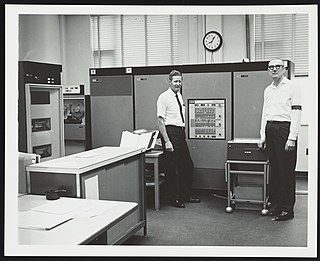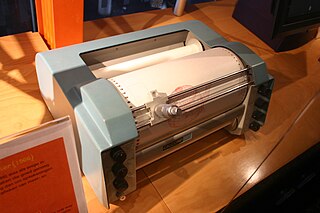
In computing, a printer is a peripheral machine which makes a persistent representation of graphics or text, usually on paper. While most output is human-readable, bar code printers are an example of an expanded use for printers. Different types of printers include 3D printers, inkjet printers, laser printers, and thermal printers.

A plotter is a machine that produces vector graphics drawings. Plotters draw lines on paper using a pen, or in some applications, use a knife to cut a material like vinyl or leather. In the latter case, they are sometimes known as a cutting plotter.

A line printer prints one entire line of text before advancing to another line. Most early line printers were impact printers.

The IBM 1620 was announced by IBM on October 21, 1959, and marketed as an inexpensive scientific computer. After a total production of about two thousand machines, it was withdrawn on November 19, 1970. Modified versions of the 1620 were used as the CPU of the IBM 1710 and IBM 1720 Industrial Process Control Systems.

A seismogram is a graph output by a seismograph. It is a record of the ground motion at a measuring station as a function of time. Seismograms typically record motions in three cartesian axes, with the z axis perpendicular to the Earth's surface and the x- and y- axes parallel to the surface. The energy measured in a seismogram may result from an earthquake or from some other source, such as an explosion. Seismograms can record many things, and record many little waves, called microseisms. These tiny microseisms can be caused by heavy traffic near the seismograph, waves hitting a beach, the wind, and any number of other ordinary things that cause some shaking of the seismograph.

The IBM 1800 Data Acquisition and Control System (DACS) was a process control variant of the IBM 1130 with two extra instructions, extra I/O capabilities, 'selector channel like' cycle-stealing capability and three hardware index registers.

Calcomp plotters were the best known products of the California Computer Products company.

The IBM 407 Accounting Machine, introduced in 1949, was one of a long line of IBM tabulating machines dating back to the days of Herman Hollerith. It had a card reader and printer; a summary punch could be attached. Processing was directed by a control panel.

The IBM 1132 line printer was the normal printer for the IBM 1130 computer system. It printed 120 character lines at 80 lines per minute. The character set consisted of numbers, upper-case letters and some special characters.

The IBM 729 Magnetic Tape Unit was IBM's iconic tape mass storage system from the late 1950s through the mid-1960s. Part of the IBM 7 track family of tape units, it was used on late 700, most 7000 and many 1400 series computers. Like its predecessor, the IBM 727 and many successors, the 729 used 1/2 inch (12.7 mm) magnetic tape up to 2400 feet long wound on reels up to 10½ inch (267 mm) diameter. To allow rapid tape acceleration, long vacuum columns were placed between the tape reels and the read/write heads to absorb sudden increases in tape tension which would otherwise break the tape. Write protection was provided by a removable plastic ring in the back of the tape reel.
The UNISERVO tape drive was the primary I/O device on the UNIVAC I computer. It was the first tape drive for a commercially sold computer.

The Bendix G-15 is a computer introduced in 1956 by the Bendix Corporation, Computer Division, Los Angeles, California. It is about 5 by 3 by 3 feet and weighs about 966 pounds (438 kg). The G-15 has a drum memory of 2,160 29-bit words, along with 20 words used for special purposes and rapid-access storage. The base system, without peripherals, cost $49,500. A working model cost around $60,000. It could also be rented for $1,485 per month. It was meant for scientific and industrial markets. The series was gradually discontinued when Control Data Corporation took over the Bendix computer division in 1963.

The Teletype Model 33 is an electromechanical teleprinter designed for light-duty office use. It is less rugged and cost less than earlier Teletype machines. The Teletype Corporation introduced the Model 33 as a commercial product in 1963 after being originally designed for the United States Navy. There are three versions of the Model 33:
The 3480 tape format is a magnetic tape data storage format developed by IBM. The tape is one-half inch (13 mm) wide and is packaged in a 4 in × 5 in × 1 in cartridge. The cartridge contains a single reel; the takeup reel is inside the tape drive.
Magnetic-tape data storage is a system for storing digital information on magnetic tape using digital recording.

The NCR Century 100 was NCR's first all integrated circuit computer built in 1968. All logic gates were created by wire-wrapping NAND gates together to form flip-flops and other complex circuits. The console of the system had only 18 lights and switches and allowed entry of a boot routine, or changes to loaded programs or data in memory. A typewriter console was also available.
Calcomp Technology, Inc., often referred to as Calcomp or CalComp, was a company best known for its Calcomp plotters.
DAC-1, for Design Augmented by Computer, was one of the earliest graphical computer aided design systems. Developed by General Motors, IBM was brought in as a partner in 1960 and the two developed the system and released it to production in 1963. It was publicly unveiled at the Fall Joint Computer Conference in Detroit 1964. GM used the DAC system, continually modified, into the 1970s when it was succeeded by CADANCE.

The IBM 3800 is a discontinued continuous forms laser printer designed and manufactured by IBM. It is significant as a product because it was both the first laser printer manufactured by IBM, and the first commercially available continuous forms laser printer.
The IBM 1443 Printer is an obsolete computer line printer used in the punched card era. It was offered in three models: Models 1, 2 and N1; the last two could print up to 240 lines per minute (LPM) with a full character set.

















